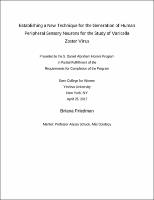Please use this identifier to cite or link to this item:
https://hdl.handle.net/20.500.12202/4005Full metadata record
| DC Field | Value | Language |
|---|---|---|
| dc.contributor.author | Friedman, Briana | - |
| dc.date.accessioned | 2018-10-18T17:48:20Z | - |
| dc.date.available | 2018-10-18T17:48:20Z | - |
| dc.date.issued | 2017-04-25 | - |
| dc.identifier.uri | https://hdl.handle.net/20.500.12202/4005 | - |
| dc.identifier.uri | https://ezproxy.yu.edu/login?url=https://repository.yu.edu/handle/20.500.12202/4005 | |
| dc.description | The file is restricted for YU community access only. | en_US |
| dc.description.abstract | VZV (Varicella Zoster Virus or human herpesvirus 3, HHV-3) is a pathogenic human alpha herpesvirus that causes varicella (chicken pox). Primary infection begins with itchy, inflamed blisters on the surface of the skin. Infection also takes place in the peripheral nervous system and establishes a long period of latency in the peripheral nervous system. After a variable period of time, the virus can reactivate, due to a variety of factors, including increased age and immunosuppression. The reactivated virus causes herpes zoster (shingles), characterized by extremely painful vesicular skin eruptions and frequently complicated by acute pain, diverse neurological sequelae, vision problems, and long lasting post-herpetic neuralgia. | en_US |
| dc.description.sponsorship | S. Daniel Abraham Honors Program | en_US |
| dc.publisher | Stern College for Women | en_US |
| dc.rights | Attribution-NonCommercial-NoDerivs 3.0 United States | * |
| dc.rights.uri | http://creativecommons.org/licenses/by-nc-nd/3.0/us/ | * |
| dc.subject | Varicella-zoster virus | en_US |
| dc.subject | Chickenpox | en_US |
| dc.subject | Shingles (Disease) | en_US |
| dc.title | Establishing a New Technique for the Generation of Human Peripheral Sensory Neurons for the Study of Varicella Zoster Virus | en_US |
| dc.type | Thesis | en_US |
| Appears in Collections: | S. Daniel Abraham Honors Student Theses | |
Files in This Item:
| File | Description | Size | Format | |
|---|---|---|---|---|
| Briana-Friedman.pdf Restricted Access | 446.86 kB | Adobe PDF |  View/Open |
This item is licensed under a Creative Commons License

